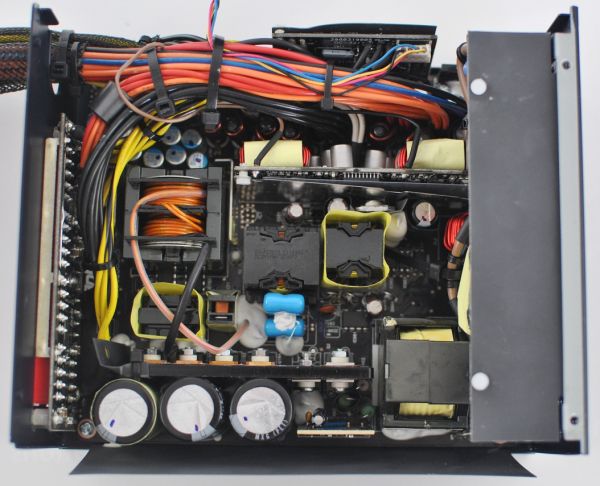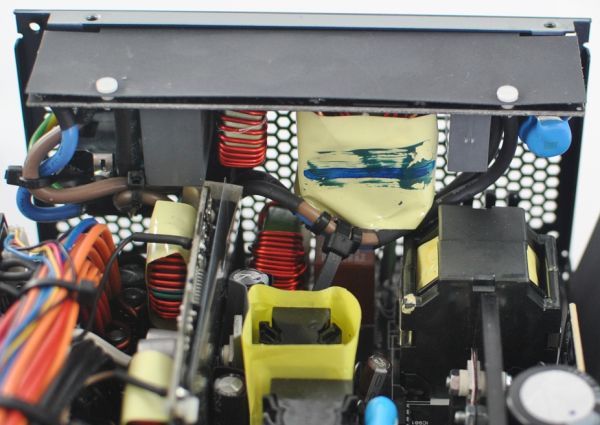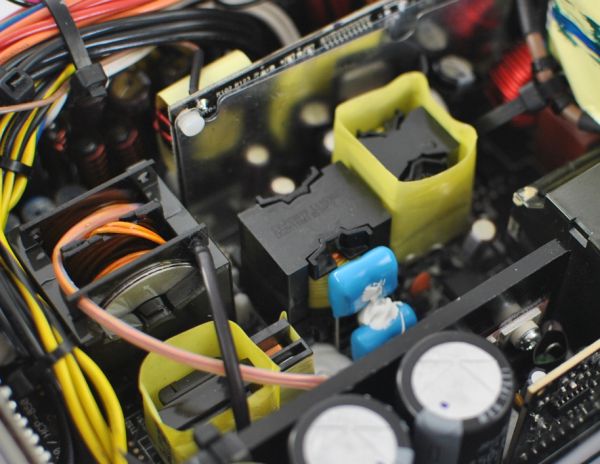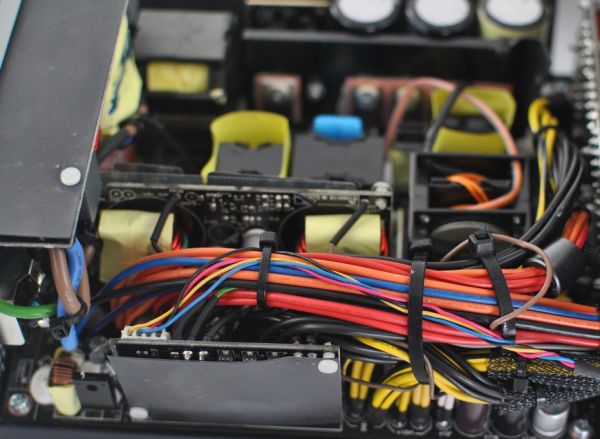Antec HCP-750 80 Plus Gold
by Martin Kaffei on October 26, 2011 4:35 AM EST- Posted in
- Cases/Cooling/PSUs
- PSUs
- Antec
- 80Plus Gold
- 750W
- High Current Pro
Internal Design and Components
The manufacturer for the HCP-750 is Delta Electronics, just like the HCP-1200, but there are clear differences between the two designs. First, Antec uses a resonant converter like Enermax and Seasonic; on the input side, however, a full bridge circuit is used. Furthermore, the model has two major PCBs, where the smaller board is only used for portions of the EMI filtering. Another significant change is that the power supply is cooled vertically by a large fan. It is striking that no rectifiers are installed in the secondary side—at least no THT components and heatsinks. You'll get the detailed description when we take a look on the secondary circuit in a moment. Where needed, a protective foil against short circuits is used. The output wires are grouped together with serveral cable ties.
Behind the AC input are a total of eight Y-capacitors from China, two common mode chokes, two X-capacitors, a linear choke, a MOV, a thermistor, and a relay. Thus the HCP is well equipped in order to suppress interference from the power grid. Both the phase and the neutral conductor have a large wire cross-section. From this point of view it is noticeable that there is not too much space for ventilation. The small additional PCB on top is the reason for this limitation, but the air is pushed down anyway and flows primarily along the board to the outside. Even though some of the upper ventilation holes are blocked, cooling shouldn't be a problem.
The two rectifier bridges with a common heatsink can rectify an alternating current with an RMS value of 25A—at least with the specified ambient temperature and a corresponding size of the heatsink as in the data sheet. In the power factor preregulator we can find three Rubycon capacitors (MXG, 22mm diameter), two Infineon MOSFETs with a low turn-on resistance, and a PFC choke with its own plastic case The FAN6982-IC regulates the current and is designed for continuous current mode (CCM).
The full bridge circuit consists of two half-bridges (two transistors each), which switch alternately. As usual for this variant, the two half-bridges work with the same duty cycle and are phase-shifted. In this case the phase is not the phase conductor, but the phase angle. Thus there is a phase modulation with two time-shifted oscillations through both half-bridges. Especially for a high power output this circuit topology is ideal.
On the output side the full oscillation is rectified, without the need for using a buffer (chokes). Since the resonant circuit makes zero-voltage switching possible, the switching losses are low and the switching frequency can be increased dramatically compared to hard switching topologies.
The four-quadrant operation is crucial for the transformer size, in which not only the first quadrant can be used, but also all negative values (or positive and negative in Q2 and Q4). This is why the transformer and the remaining passive components in this type of converter can be significantly smaller.
Nobody should be concerned by the small main transformer. Here we have a true 750W power supply, and the design principle of this converter is suitable for 1 KW and more. Important for this design is the separate resonant circuit, so no parasitic effects are used to allow ZVS. This could, for example, be the capacitances between two conductors, transformer windings, or between the gate and bulk terminal of the MOSFETs, plus the natural magnetic fields of all conductors and leakage inductivity.
Output side, the two buck converters for +5V and +3.3V are on an additional board. All direct currents run through a circuit made up of rod core inductors and Japanese capacitors. The PCB on the bottom of the 4-pin fan is connected and controlled by the duty cycle. All +12V outputs are protected by OCP, and the cables are fitted with heat-shrink tubing. On the far left we see a small linear regulator for -12V. The MOSFETs for +12V rectification can be found on the back of the main PCB. They are connected via a thermal pad to the housing and can be run almost uncooled at the specified performance. The losses in the semiconductors should be very low.















34 Comments
View All Comments
piroroadkill - Wednesday, October 26, 2011 - link
That said, just to say, this Antec is made by Delta, and some of their new high end designs such as Antec Signature in their new PSU size (120mm rear fan) are also made by Delta, and are some of the highest rated power supplies going.Really, there are so many OEMs in this game under the same brand, you have to learn what you're looking at.
The best site for this, bar none, is jonnyguru.com
Rick83 - Wednesday, October 26, 2011 - link
Sadly you can't even judge a PSU by its OEM.The same OEMs may build to vastly different standards - so even some chinese OEM that's been building firebombs for decades may get a contract to build a high-end PSU, and there's no real reason they wouldn't be able to do it, if they have the work force and know-how - both of which aren't that special in the PSU sector.
In the end, don't buy by names or OEMs or brands or whatever - but look at as many reviews as possible, to verify that in every test the protection circuitry performed and noise was low, as well as the efficiency being the one that's indicated by the 80+ label.
Even then there's a certain risk you end up with a monday's PSU, but odds are mostly in your favor..
buzznut - Thursday, October 27, 2011 - link
I completely agree with this post. It is just like asking, "Which brand video card do I buy?" The best one available in your price range, do your homework.Each PSU should be taken on its own merits. I always thought Kingwin power supplies look flashy but I would have bet they aren't that great. Then I find out some of the high end ones they've released in the last year are outstanding, from Superflower. I'm speaking in particular about the Gold Series.
piroroadkill - Thursday, October 27, 2011 - link
Platinum, too. Super Flower has a platinum platform.As always, I recommend jonnyguru.com
radium69 - Thursday, October 27, 2011 - link
I got the platinum one, its awesome by any standards!Stuka87 - Wednesday, October 26, 2011 - link
Antec does not build most of their supplies. They are build by OEM's. My Antec is made by Sea Sonic for instance (great supply).Corsair does not build any of their supplies at all. And they actually use the same manufacturer that Antec uses for some of their supplies.
Sorry you had a supply fail, it can happen with any brand. But saying you hate Antec yet love Corsair is kind of hypocritical. Kind of like saying you hate the Pontiac Vibe yet love the Toyota Matrix, when in fact they are the same car made in the same factory (well, back when they are being made anyway).
zero2dash - Wednesday, October 26, 2011 - link
before I buy another CX series Corsair.I bought 1 for a customer build, a CX500. It has coil whine.
Yes I know coil whine is harmless but that's beside the point. It shouldn't make any noise other than the fan inside of it when it ramps up at a higher load/temp.
Just because I've had a bad experience with a CX doesn't mean I'm not going to continue buying Corsair. I've got an HX850 and a TX650 right now happily chugging along. In the past I had an HX520 and a VX550. The VX550 eventually got killed after about 2 years of use (from Folding@home I suspect), but it was replaced under warranty. I'll still buy Corsairs in the future.
My work rig has an Antec Neo Eco 620. No problems.
Last customer build I put together I was trying to stay on the cheap and I went with the Rosewill Green series S2 620 after seeing the great review on Hardware Secrets. I've had no complaints of problems from my customer yet on that one (and I was leery of that one, being a Rosewill product....even though I knew internally it was an ATNG).
Those points aside - you roll the dice with any psu. I've seen people on various sites/forums with dead Corsair's, Antec's, Enermax's, Silverstone's, etc [enter psu manufacturer here].
geniekid - Wednesday, October 26, 2011 - link
As noted by other posters, Antec and Corsair aren't OEMs. Tom's has a great article listing all power supply sellers and the OEMs behind each line as well as how to figure out which power supply you actually have.http://www.tomshardware.com/reviews/power-supply-o...
I'll also take this opportunity to give Seasonic a thumbs up, based solely on personal experience.
Mr.T - Thursday, October 27, 2011 - link
Oh wow, that Tom's article is really cool; It's nice to who the manufacturer actually is up the production chain.So it seems my PC Power&Cooling PSU was manufactured by Seasonic. Quite happy with that. I'll echo the Seasonic love then, as it's been running strong for 4 years now and it's not going anywhere either (thankfully, 750W is still plenty enough).
Martin Kaffei - Thursday, October 27, 2011 - link
Well, this article uses old information. I already did something like that in 2008 on ComputerBase (in German).Moreover you should know that some brands have a number, even if they are no real manufacturer (In Win e.g.). Today the UL number is unhelpfully. It's better to take a look at my articles. Usually I write something about the real ODM. Just like in this review.